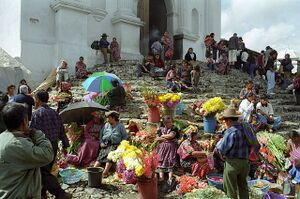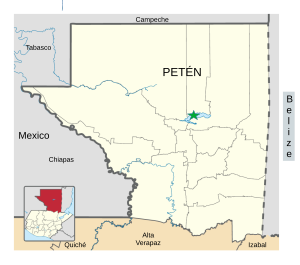The aim of this page is to recognise, celebrate and encourage the self-empowerment of community agency networks (CANs) and community groups across Guatemala.

 International development can tackle the climate and migration crises together, theconversation.com (May 21, 2024)
International development can tackle the climate and migration crises together, theconversation.com (May 21, 2024)
Networks and sustainability initiatives[edit | edit source]
- Buena Semilla, video channel on youtube.com, added 16:56, 9 December 2023 (UTC)
- Neighbourhood initiatives across Guatemala City
Biodiversity[edit | edit source]
The Maya Biosphere Reserve (Spanish: Reserva de la Biosfera Maya) is a nature reserve in Guatemala managed by Guatemala's National Council of Protected Areas (CONAP). The Maya Biosphere Reserve covers an area of 21,602 km2, one-fifth of the country's total land area.
The park is home to a large number of species of fauna including Morelet's crocodile and the ocellated turkey. It is also rich in flora including breadnut, mahogany, Swietenia humilis, Bloma prisca, Vitex gaumeri, cedar, Bucida buceras, Haematoxylum campechianum, Rhizophora mangle, and Pimenta dioica. The area ranges from wetlands, to low mountain ranges, and has several bodies of water, including lakes, rivers, streams and cenotes.
The Reserve was created in 1990 to protect the largest area of American tropical forest remaining north of the Amazon. The biosphere reserve model, implemented by UNESCO, seeks to promote a balance between human activities and the biosphere by including sustainable economic development in conservation planning.
Reduce, reuse, repair and recycle[edit | edit source]
Trees, woodland and forest[edit | edit source]

AFISAP, which was founded in 1999, is focused on preserving the forests on a 52,000-hectare concession within the Mayan Biosphere Reserve in the San Andres area which plays a critical role in regional conservation. According to an AFISAP study that used remote cameras, the Mayan Reserve has the highest-density of jaguars ever reported in the world (11 jaguars/100 km2).
The organization, which has distinguished itself as one of the most successful community groups in Guatemala, has also introduced projects to extract the lucrative xate, the popular foliage used for floral arrangements worldwide. Xate, which has been used for 40 years and is exported, has brought enormous economic benefits for the rural communities in the area.[1]
News and comment[edit | edit source]
2023
 Circles of hope: the Guatemalan women reviving Indigenous concepts of mental wellbeing, positive.news (Dec 08, 2023)
Circles of hope: the Guatemalan women reviving Indigenous concepts of mental wellbeing, positive.news (Dec 08, 2023)
2016
Justice in Guatemala: Guatemalan Court Upholds Revolutionary Ruling on Ecocide, Courtney Parker January 1[2]
About Guatemala[edit | edit source]
Guatemala, officially the Republic of Guatemala, is a country in Central America. It is bordered to the north and west by Mexico, to the northeast by Belize, to the east by Honduras, and to the southeast by El Salvador. It is hydrologically bordered to the south by the Pacific Ocean and to the northeast by the Gulf of Honduras.
The territory of modern Guatemala hosted the core of the Maya civilization, which extended across Mesoamerica; in the 16th century, most of this was conquered by the Spanish and claimed as part of the viceroyalty of New Spain. Guatemala attained independence from Spain and Mexico in 1821. From 1823 to 1841, it was part of the Federal Republic of Central America.For the latter half of the 19th century, Guatemala suffered instability and civil strife. From the early 20th century, it was ruled by a series of dictators backed by the United States. In 1944, authoritarian leader Jorge Ubico was overthrown by a pro-democratic military coup, initiating a decade-long revolution that led to social and economic reforms. In 1954, a US-backed military coup ended the revolution and installed a dictatorship.From 1960 to 1996, Guatemala endured a bloody civil war fought between the US-backed government and leftist rebels, including genocidal massacres of the Maya population perpetrated by the Guatemalan military. The United Nations negotiated a peace accord, resulting in economic growth and successive democratic elections.
References[edit | edit source]
- ↑ unep.org, 23 February 2011
- ↑ intercontinentalcry.org
